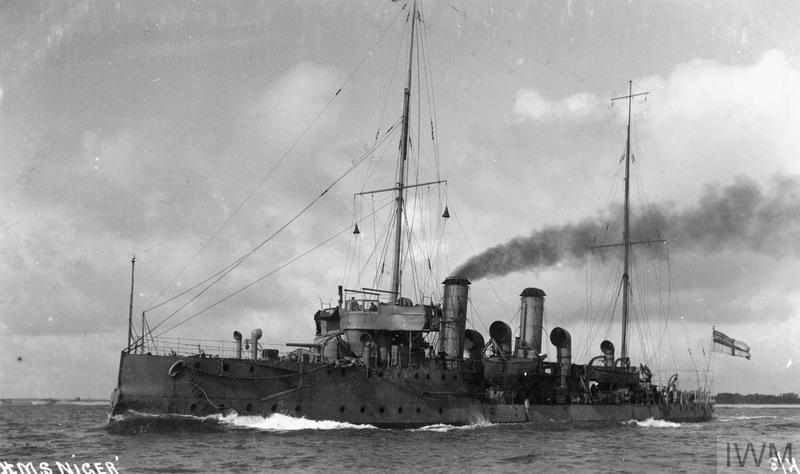- Yes
- No
Alarm-class torpedo gunboat, HMS Niger (1892)
Vehicle design and history:
The Alarm class torpdeo gunboats were designed by Sir William White in 1889, as an enlarged version of the previous Sharpshooter class. The vessels in this class had a overal length of 242 ft (74 m), a beam of 27 ft (8.2 m) and a total displacement of 810 tons. The ships were engineed with two sets of vertical triple expansion steam engines, two locomotive type boilers and a pair of twin screws. With this layout the engines were able to produce 3.500 indicated horsepower (2,600 kW), giving the ships in this class a respectable top speed of 18.7 knots (34.6 km/h). The engines were powered by coal, of which around 100 t0 160 tons where carried on board. The ships in this class as standard were manned by a compliment of 91 sailors and officers.
As built the class was fitted with two QF 4.7-inch (12 cm)/45-pounder guns, four 3-pounder guns and one Gardner machine gun. This fire power was supplimented by five 14-inch (360 mm) torpedo tubes fitted in the first five vessels. This would be changed to three three 18-inch (450mm) torpedo tubes in the rest of the class which includes HMS Niger, which was the 9th ship built. These larger torpeods were arranged in a pair of revolving deck mounts and a single bow-mounted tube, all tubes in turn were provided with three reloads, giving these vessels an impressive torpedo salvo in regards to their size.
Service History:
HMS Niger was ordered from the Naval Construction & Armament shipyard, Barrow in furness, and was laid down on 17 September 1891. Construction was rather straightforward, and she was launched on the 17th of december, and was officially finished fitted out and was commissioned on the 25th of april 1893. The first ten years of her service was overall uneventful, and she underwent refit at Palmers Shipbuilding Company in 1902, where she was fitted with new and larger engines powered by reed water tubed boilers. Upon this refit being completed she relieved HMS Jaseur as tender to HMS Vernon, where she would also serve as a training ship.
HMS Niger is most famous for the action that took place on the morning of November 11th 1914, where before noon a U-boat attack occured off Deal where she was sunk by SMS U-12. Before the attack HMS Niger was anchored about two miles off the pier of Deal, before out of the blue a large explosion tore through the vessel, kicking up a black plume of smoke. The damage causing the ship to list and inevitably sink, marking her the first ship sunk by the soon to be legendary U-boat commander Walther Forstmann, who would go on to be one of the most successful commanders of the Imperial German Navy in ww1. This would also be the first Allied ship to be sunk by a german submarine from their newly captured naval bases in belgium. Due to the high winds and huge waves the situation was rather dire for those aboard the stricken HMS Niger, made worse by the fact the majority of the crew had been enjoying lunch at the time of the attack, and most were lightly dressed. thankfully more than 100 vessels were within the vecinity of the ship, and many came to the aid of the vessel allowing all officers and 77 of the crew to survive the sinking, though four survivours being injured, with two critically from the initial blast. The commander of the ship Lieutenant-Commander Arthur Thomas Muir preformed admirably, as he remained on the bridge until the rest of the crew had been safely evacuated, and he remained standing despite the serious injuries he sustained in the initial explosion. The injured were taken to a nearby royal navy hospital.
As an interesting foot note, the commander of the naval squadron HMS Niger was assigned to was the legendary Geoffrey Spicer-Simson, who asside from being rather eccentric, is famous for leading a small floatilla to defeat the superior german force in the battle for Lake Tanganyika. At the time of the sinking he was visiting his wife and some of her lady friends at a nearby hotel.
Specifications:
Class and type: Alarm-class torpedo gunboat
Displacement: 810 long tons (823t)
Length: 74 m (242 ft 9 in)
Beam: 33 m (108 ft 3 in)
Draught: 8.2 m (26 ft 11 in)
Propulsion: 2 three-cylinder steam engines
Speed: 18.7 knots (34.6 km/h; 21.5 mph)
Complement: 91
Armament: 1 × fixed bow 18-inch (450mm) torpedo tube with two additional reloads
2 × revolving 18-inch torpedo tubes with two additional reloads
2 × QF 4.7-inch (12 cm) guns
4 × 3-pounder guns
1 × Gardner machine gun
Historical photos:
Hide contents
Hide contents
Hide contents
Close up view of one of HMS Niger’s swivel torpedo tube, showing one of the three torpedos each mount was supplied with:
Hide contents
Sources:
- Major rescue operation for crew of Barrow ship hit by German torpedo | The Mail
- Cocker, M. P. & Maurice Cocker (2006). Coastal Forces Vessels of the Royal Navy from 1865. Tempus. ISBN 9780752438627.
- The Project Gutenberg eBook of The Illustrated War News, Part 15, November 18, 1914, by Various. (page 6)
- https://paperspast.natlib.govt.nz/newspapers/PBH19141231.2.33 ( period News article about the sinking)
- Alarm-class torpedo gunboat - Wikipedia
- HMS Niger (1892) - Wikipedia




